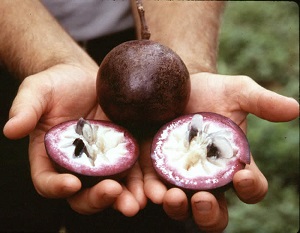From Fairchild
Tropical Botanic Garden
by Noris Ledesma, Curator of Tropical fruit
The Star Apple
(Chrysophyllum cainito)
As published in the Miami Herald
Star Apple (Chrysophyllum
cainito) is a tropical fruit native to the
lowlands of Central America and West India. The fruit has a star like
design when it is sliced, hence its common name Star Apple.

The star apple its mostly appreciated as a fruit tree in home
landscapes. It is a beautiful tree, making a perfect tree for
landscaping in South Florida. The canopy opens forming an umbrella
shape where the underside leaves shines with a golden brown color
meanwhile the upper side shines with an emerald green color. The tiny
flowers are purplish white and have a sweet fragrant smell than
attracts hummingbirds and bees.
The fruit exist in two colors, dark purple and green. The purple fruit
has a denser skin and texture while the greenish fruit has a thin skin
and a more liquid pulp. Both have a delicate flesh that explodes with
juice in your mouth with each bite. The star apple fruit range from
sweet with just a hint of perfume to sweet floral aroma. Star apple go
under a number of names including cainito, caimito, golden leaf tree,
and milk fruit.
Fairchild Tropical Botanic Garden has been selecting superior varieties
of star apple in different locations with emphasis from the Pacific
coast of Costa Rica. These selections are purple and green skinned and
were selected for superior production and fruit quality.
Enthusiasm for growing and eating uncommon fruits will probably create
a need for skills in plant propagation. The star apple can be
propagated by cuttings, air layers or grafting. Seed propagation can be
used to develop new cultivars. The fruits of seedlings may not match
the quality of its parent and in some cases you must wait many years
before a seedling bears its first fruit. A small commercial industry of
star apple exits in south Florida and Local nurseries carry grafted
varieties, including 'Haitian Star', a purple peel type, and 'Blanco
Star', a green peel type.
All varieties should be planted in the late spring. Start pruning for
the future when the tree still young. Proper training also will shape
the tree to a form that allows all the branches to be bathed in air and
sufficient light, even when the tree goes old. In the first years the
branches should be tipped to encourage the formation of a bushy canopy.
A canopy with many branches will bloom earlier than a canopy without
pruning. Annual pruning of will trees at a manageable height and
provide ready access to the fruit.
The trees should be fertilized three times per year (March, July and
September) using 8-3-9 or other fruit tree formulation. In the home
landscape the tree will require no irrigation after establishment.
Mature trees are seriously injured by low temperatures (below
28º F).
Star apple will start blooming from August to October depending of the
cultivar, and fruit are generally harvested from late winter or early
spring to early summer. Fruit do not fall when ripe and therefore must
be harvested by hand when fully mature. Fruit are fully mature when the
skin color turns a dull color (purple or green) and is slightly
wrinkled and soft. Immature fruit will be astringent and inedible due
to the gummy latex found in the flesh. Once mature fruit are picked,
they may be allowed to fully ripen at room temperature. Once ripe,
fruit may be stored in the refrigerator until consumed.
The fruit has is a good source of vitamin C, rich in minerals, and
potassium. The fruits are delicious as a fresh dessert fruit. The ripe
fruit, preferably chilled, may be merely cut in half and the flesh
spooned out, leaving the seed cells and core. The sweet fruits are
eaten raw and in desserts and salads. They are also boiled and made
into preserves. An interesting drink called "matrimony" is prepared by
scooping out the inside pulp of a star apple and adding it to a glass
of sour orange juice.
Back
to
Star Apple Page
|
|
